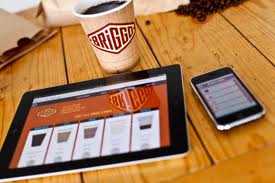Humans have proven to be highly adaptable when it comes to replacing personal service with that of a computer. We survive without a ticket agent at the airport, a cashier at the grocery store and a teller at the bank. There are kiosks that identify us by our palms, check out our library books and even make pizza with customized toppings.
But what happens when a machine displaces someone we really care about — someone who knows our personal routines, remembers our quirky tastes and sometimes talks to us before anyone else in the morning? How on earth will humankind react when a robot supplants our barista?
One company is betting that humankind will actually dig it.
Austin-based Briggo has spent the last 18 months testing a robotic barista at the University of Texas at Austin’s Flawn Academic Center. Founded by Motorola veteran and self-professed engineering geek Chas Studor, Briggo produces organic coffee (using fresh, hormone-free milk and natural syrups) with a precision and consistency wholly unattainable by humans. But equally pioneering: Customers benefit from the innovative technology — remote ordering, personalization and notification when the drink is ready. About the only thing the Briggo robot doesn’t do is ask you how your day’s going.
As Briggo’s beta phase comes to a close, it’s gearing up to introduce its new kiosk this summer — one that will replace the existing kiosk on campus. It’s smaller, smarter, offers more options, requires even less human interface and is poised to take up residence at other universities, train stations, hospitals, corporate campuses and shopping centers. Briggo will open a kiosk at Austin Bergstrom International Airport this fall.
To be fair, Briggo executives are hardly out to eradicate the human barista. “The human element of coffee shops is beautiful,” said Briggo president and CEO Kevin Nater, “but inconsistent.” He has heard all sorts of coffee shop horror stories, like people becoming short of breath when their barista isn’t working. So just when we thought the coffee market was saturated, Briggo is filling a void — one that serves the coffee drinker who wants to use smart technology for a high-end, mobile-friendly coffee experience.
And the fully caffeinated Briggo team is thinking big. “We’re not talking 10 to 20 kiosks,” said Nater, a former banker and Dell executive. “We’re talking thousands.” Yet even then, he expects Briggo to capture only a few percentage points of the coffee market. “We’re not,” he said, “asking people to stop going to coffee shops.”
Disrupting the coffee routine I visited Briggo early this year, at the end of student break, so the student center was quiet. Still, customers occasionally wandered over to the kiosk to pick up their pre-ordered coffee drinks. The kiosk was a large orange and white box with monitors that announced when a drink was ready and a touch screen for those who hadn’t ordered remotely.
Nater pulled out his iPhone and entered “Melanie” as the pick-up name so the robot would announce that the drink he was about to order was for me. Customers place (and pay for) orders on their computer, mobile device or at the kiosk touch screen. When they open an account, the first drink is free. The order goes up into the cloud and lands with the robot, who then sends a reply, indicating the wait time. All the customer’s preferences are saved, so they can re-order their favorite drinks — with, for instance, a certain number of vanilla shots or certain amount of sugar.
“I can order from anywhere in the world,” Nater explained. “Say you’re in exams, and your parents know you’re near this location and probably need some caffeine. They can order a drink, and you will get a message saying it’s ready.”
Nater took my order and touched the buttons for a hot soy chai. In just a couple minutes, I saw my name in big bold letters on the monitor. At the same moment, Nater received a text, “Your chai latte is ready for pickup at Briggo.” A student named Mason was working as a kiosk attendant — interacting with users, educating them about the process and physically picking up the cup from the robot to hand to the customer. In the new version, even her job will be obsolete.
Nater said that traditionally, a student leaves class, walks 10 minutes to the Starbucks and waits 15 minutes for a drink. “This allows you to fit more into your day,” he said. “We’re not asking you to fit into our coffee shop experience.”
There are a half-dozen traditional places to get coffee within about a five-minute walk of the Briggo kiosk. Yet there are hundreds of people who work in the building where Briggo is located, and thousands more pass it on a regular basis. Today, Briggo has more than 3,000 accounts (about 80 percent of its business is from repeat customers), which tells Nater that the concept is working. “We think it’s pretty disruptive.”
First, a gourmet coffee company Mason handed me my chai, made from organic Pacific soy milk and organic Third Street chai from Colorado. There was a small receipt stuck to the side of the cup with my name, the name of the drink, the date, time, price and an ID number. The drink lacked nothing in the flavor department.
Patrick Pierce is Briggo’s director of coffee and kiosk operations. A former champion on the barista competition circuit, where coffee-making is an art, Pierce is now responsible for feeding the robot high-quality ingredients, like coffee beans roasted within the week and syrups imported from France. The Briggo mantra is that it’s first and foremost a gourmet coffee company — not a technology or device company.
Nater and Pierce invited me behind the curtain, er, door, where the magic takes place. Several of us easily fit inside, along with backup supplies and enough cool moving parts to make Willy Wonka green with envy. Nater ordered another drink on his smart phone so I could see the operation from inside. Shortly after placing the order, I watched a monitor do the math behind a latte. Numbers on the screen flashed quickly like digits on a blood pressure monitor, measuring things like temperature, pressure and weight — all the calibrations that would concern a barista.
Inside the robot, every cup of coffee is ground fresh. Brewed coffee takes 15 to 30 seconds per drink, and espresso takes up to two-and-a-half minutes. I watched the machine heating the milk while the grounds were tamped with a real tamper. Metal arms moved up and down, twisted and rotated. When the latte was complete, I heard the sound of water — like any good robot, it cleaned itself after every order.
The right place for robotic coffee Terry Mahlum, regional director for Delaware North Companies Travel Hospitality Services, which operates 300 restaurants and retail outlets in more than 25 airports around the globe, saw the Briggo kiosk on the University of Texas campus and envisioned it at the local airport.
“It’s a good fit in Austin, with all the innovation and high-tech there,” he said. “It’s the right place for robotic coffee.”
The kiosk is slated for a central location across from Gate 13 in the American Airlines terminal. The new version, only 50 square feet, will appeal to the business traveler and anyone else on the move. For travelers who still want the human touch, the airport has five other coffee shop options.
“We’re going to promote Briggo pre-security,” Mahlum said. “So passengers will be able to get on their mobile apps and place the order while they’re standing in the security line.”
Samuel Nahmias, executive vice president and chief operating officer of StudyLogic, a research firm whose clients include the top coffee chains, hasn’t tried the Briggo drinks, but he was impressed by the price — $1.40 for a cup of organic coffee. “If the price of specialty coffee is lower, the benefit is purely financial,” he said. “It will provide a great cup of coffee to the world while saving on employee costs.”
Nahmias is no stranger to food robots. He grew up in Mexico City, and his private school had a French fry machine. “I put my pesos in and it molded fries out of potato starch,” he said. There are machines for all sorts of food and beverage products, but he said there’s something special about the human touch with coffee.
“People like to go in and say, ‘Good morning, Sandy,’” he said. “There’s that personalization when you talk to someone. You want to see Sandy and say hello.” He said the other concern with any machine is that machines can fail, so the challenge for Briggo is to prove that the concept works. Finally, he said a customer wouldn’t be able to go back to the machine and ask for a touch more milk or another pump of syrup. “When the machine is done, it’s done.”
But he likes the fact that Briggo’s robot stores drink preferences so customers can easily repeat an order — which is more advanced than machines like the Rubi, the coffee kiosk owned by Redbox movie rental parent Coinstar, which serves Seattle’s Best Coffee. And Nahmias thinks Briggo could be successful in regions of the country that have high uses of mobile technology, like the East and West Coasts. “I don’t think, from a large consumer perspective,” he said, “the Midwest is ready for this yet.”
A new conversation, new coffee culture I stepped outside of the robot vortex and Nater pulled out his iPad, showing me renderings of the new Briggo robot, which was designed by an internationally recognized industrial design firm. It’s a radical change (two-thirds smaller) from the comparatively clunky beta model; it looks like a narrow little cabin or playhouse, with a monitor and pick-up area on the side and a couple bar stools on the end.
The new version includes countless upgrades. It will run totally unmanned, 24/7 (for the ER doctor at the hospital or the late-arriving passenger at the train station). Nater said the design is based partially on customer feedback: People really wanted to see the robot, so there is a window to watch the inner-workings of the machine. The company also added real wood paneling on the side to create some warmth.
The interface and logo are completely new; the menu includes more drinks (such as cappuccino and café au lait); the frothing mechanism has been perfected; and drinks are available in three sizes, for both hot and cold. Furthermore, the unit can be monitored remotely, and the design is modular. So if the frothing mechanism isn’t functioning, for example, it will send out an alert, and that one piece of machinery can be pulled and replaced by a technician.
By early this year, Briggo had raised about $9 million for the next generation robot and expansion, almost exclusively from angel investors in Austin. “Investors are hearing a lot of pitches about medical devices and energy products these days, and then they see this,” Nater said. They can relate to a cup of coffee — and they get excited about it.”
As for Nater, he’s fired up about the robot and the drinks, but he’s also eager for Briggo’s next step in social media. Currently, users can post to Facebook that they had the perfect latte at Briggo. That might pique the interest of friends, but they would then have to go to their own Briggo account to try to replicate it. With the new, more sophisticated interface, they will be able to click on a link in the Facebook post and order the exact same drink.
“Our drink is just a digital recipe,” Nater said, and now people can put it out there for their friends. “There’s such a sharing and communal aspect to coffee. This goes beyond what anyone else is doing in terms of allowing people to share an experience.”
In essence, Briggo has replaced banter with the barista with electronic social interaction, creating a way for customers to still have their morning coffee and conversation. And just like the neighborhood barista, the robot remembers what they like.
“Everything else I consume in life I want variation, but my coffee, I want exactly the same way,” Nater said. And as Briggo gets ready to expand, the company will soon know whether other coffee drinkers concur. As for the Briggo team, working overtime to revolutionize the way we think about a coffee shop, “We all could use a little more sleep,” Nater said, laughing. “But it’s not like we don’t have the stimulants.”
Source: Robotics Trends’ News Resources


















